Get the latest tech news
Evidence for transient morning water frost on the Tharsis volcanoes of Mars
High-resolution spacecraft imagery has revealed transient deposits that appear in the early mornings of cold seasons at the high altitudes of the Tharsis volcanoes on Mars, consistent with water frost of atmospheric origin.
Observations by the Colour and Stereo Surface Imaging System (CaSSIS 35) on board the European Space Agency’s (ESA’s) Trace Gas Orbiter (TGO) provide strong evidence for morning frost deposition on the equatorial Tharsis volcanoes. The MarsWRF GCM incorporates the phase transition and transport mechanisms of water vapour and ice, facilitating a parameterization of the Martian hydrological cycle that aligns with the methodologies outlined by previous studies 87. The NOMAD experiment is led by the Royal Belgian Institute for Space Aeronomy (IASB-BIRA), assisted by Co-PI teams from Spain (IAA-CSIC), Italy (INAF-IAPS) and the United Kingdom (Open University).
Or read this on Hacker News


